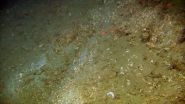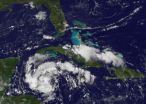(Press-News.org) NARRAGANSETT, R.I. – September 14, 2010 – When a federal fisheries scientist sought to learn how ocean currents affect the catch rate of lobsters, he turned to a University of Rhode Island oceanographer who had developed an innovative and inexpensive meter for measuring currents near the bottom of bays, rivers and other shallow waters.
So did aquaculture farmers in Rhode Island looking to identify the best site for farming oysters, Cape Cod officials interested in understanding tidal fluctuations in Waquoit Bay, and students at Cohasset (Mass.) High School studying circulation patterns in Cohasset Bay.
They all called on Vitalii Sheremet, associate marine research scientist at URI's Graduate School of Oceanography, whose expertise about currents, tides and waves, along with his SeaHorse tilt current meter, provided the answers.
Currents cause the meter – a buoyant plastic pipe containing an accelerometer and an electronics package that is anchored vertically to the sea floor – to tilt at an angle, with stronger currents creating a greater tilt.
"It's lightweight, it's inexpensive, it's easy to deploy, and you can deploy large numbers of them to gain different perspectives on whatever problem you're looking at," said Sheremet.
Most current meters used by scientists cost about $15,000 each, while Sheremet's meter is only about $500, and he makes each one by hand. It takes him about a week to build and calibrate 10 of them. He hopes to have them commercially available sometime next year as soon as the final design is chosen.
Sheremet takes custom orders for his meter from fellow researchers around the world, and he has provided several dozen to URI faculty and students. They have been used in the Red Sea, the Black Sea, off the coast of Taiwan, and in the waters around New England and Hawaii.
This month, 50 meters are being deployed in the Gulf of Maine to monitor the currents around lobster traps. In a joint project with Jim Manning, a researcher with the National Oceanic and Atmospheric Administration, Sheremet is studying how the orientation of lobster traps relative to the direction of the current and tides affects how many lobsters are caught. The project may boost the lobster fishing industry by indicating which direction the trap mouth should face to have the greatest likelihood of catching the valuable crustaceans.
At Waquoit Bay National Estuarine Research Reserve on Cape Cod, 35 current meters have been deployed since last fall to understand tidal flows and water circulation in the bay.
"Pollution from local rivers runs into the bay," Sheremet said. "It's important to know how the currents flush water from the bay and how larvae are transported."
Sponsored by the Office of Naval Research, the project is helping to evaluate the performance of the SeaHorse tilt current meters.
Sheremet also supervised the work of a team of Cohasset High School students this summer so they could track the flow of wastewater and storm water through Cohasset Harbor and assess how they affect the ecosystem.
"They used my meter and some homemade drifters to measure bottom currents and surface circulation and tidal oscillation in the harbor," he said. "The students learned a great deal about oceanographic measuring techniques and about ocean circulation patterns."
In October the URI scientist will present his technology at a meeting of aquaculture industry representatives. Sheremet said that it is especially important for oyster farmers to select sites that have strong currents, and his meter is the perfect device for identifying the sites with the best flow rate.
INFORMATION: END
Suppose a close friend who is trying to figure out the facts about climate change asks whether you think a scientist who has written a book on the topic is a knowledgeable and trustworthy expert. You see from the dust jacket that the author received a Ph.D. in a pertinent field from a major university, is on the faculty at another one, and is a member of the National Academy of Sciences. Would you advise your friend that the scientist seems like an "expert"?
If you are like most people, the answer is likely to be, "it depends." What it depends on, a recent study found, ...
WASHINGTON, Sept. 14, 2010 — A new genre of construction materials, made with particles barely 1/50,000th the width of a human hair, is about to play a big role in the building of homes, offices, bridges, and other structures, according to the latest episode in the American Chemical Society's (ACS) award-winning podcast series, "Global Challenges/Chemistry Solutions."
A new Global Challenges podcast and website is highlighting both the potential benefits of these nanomaterials in improving construction materials and the need for guidelines to regulate their use and ...
The first randomized, placebo-controlled U.S. clinical trial to assess the use of bone marrow-derived mononuclear cells (BMC) in patients after a ST-elevation myocardial infarction (STEMI; severe heart attack) demonstrated a strong safety profile for this cell therapy, based on phase 1 results published in the September issue of the American Heart Journal.
"The use of adult stem cells, derived from the patient's own bone marrow, presents a potential new type of therapy to benefit individuals after they suffer a heart attack," says the study's principal investigator Jay ...
EAST LANSING, Mich. — Women tend to believe the scientific consensus on global warming more than men, according to a study by a Michigan State University researcher.
The findings, published in the September issue of the journal Population and Environment, challenge common perceptions that men are more scientifically literate, said sociologist Aaron M. McCright.
"Men still claim they have a better understanding of global warming than women, even though women's beliefs align much more closely with the scientific consensus," said McCright, an associate professor with ...
The research, unveiled at a press conference today (14 September 2010), shows that the watercress compound is able to interfere with the function of a protein which plays a critical role in cancer development.
As tumours develop they rapidly outgrow their existing blood supply so they send out signals which make surrounding normal tissues grow new blood vessels into the tumour which feed them oxygen and nutrients.
The research, led by Professor Graham Packham of the University of Southampton, shows that the plant compound (called phenylethyl isothiocyanate) found ...
(PHILADELPHIA) An abrupt, fatal heart attack in a young athlete on the playing field is a tragedy destined to repeat itself over and over until more is understood about hypertrophic cardiomyopathy (HCM), a genetic disorder that is the most common cause of sudden death in young people but which affects people of all ages. So says a task force of cardiologists and cardiac biologists, headed by Thomas L. Force, M.D., James C. Wilson Professor of Medicine at Thomas Jefferson University, in the September 14th online edition of the journal Circulation.
Their special report ...
Scientists have for the first time estimated the physical footprint of human activities on the deep seafloor of the North East Atlantic. The findings published in the journal PLoS ONE reveal that the area disturbed by bottom trawling commercial fishing fleets exceeds the combined physical footprint of other major human activities considered.
The deep seafloor covers approximately 60% of Earth's surface, but only a tiny fraction of it has been studied to date. Yet as technology advances and resources from relatively shallow marine environments are depleted, human impacts ...
Global fisheries, a vital source of food and revenue throughout the world, contribute between US$225-$240 billion per year to the worldwide economy, according to four new studies released today. Researchers also concluded that healthier fisheries could have prevented malnourishment in nearly 20 million people in poorer countries.
This first comprehensive, peer-reviewed estimate of the global economic contribution of fisheries was published online today in four papers as part of a special issue of the Journal of Bioeconomics.
This research, conducted by the University ...
GOES-13 captured a look at System 92L this morning as it continues moving through the central Caribbean, and it's looking more and more like a tropical depression.
As the Geostationary Operational Environmental Satellite called GOES-13 satellite keeps relaying data to NOAA (who manages the satellite) and the NASA GOES Project at NASA's Goddard Space Flight Center in Greenbelt, Md., the images created by the NASA GOES Project reveal that System 92L appears to be taking on the appearance of a tropical depression. In the imagery captured today, Sept. 14 at 1340 UTC (9:40 ...
ROCKVILLE, Maryland, September 14, 2010 – Neuralstem, Inc. (NYSE Amex: CUR) announced that its spinal cord stem cells survived in rat brains affected by stroke and differentiated predominantly into neurons. The transplanted animals showed significant improvement in some motor skill and strength measurements. The study entitled, "Intracerebral Implantation of Adherent Human Neural Stem Cells To Reverse Motor Deficits in Chronic Stroke Rats," was presented earlier today by senior study author, Dr. Shinn-Zong Lin, M.D., Ph.D., at the Stem Cells USA & Regenerative Medicine ...



